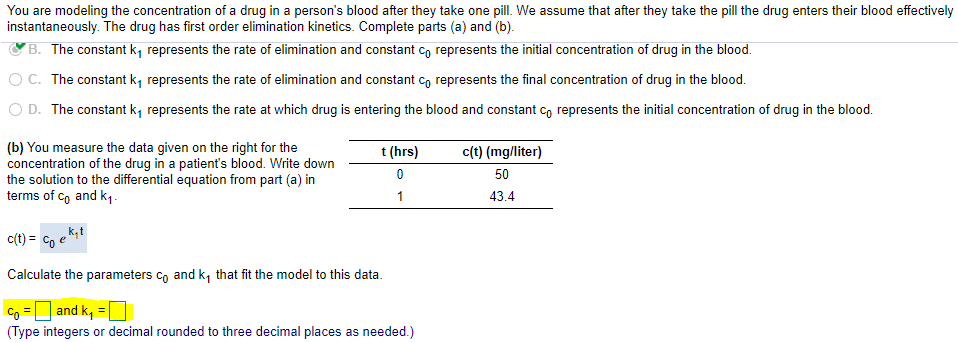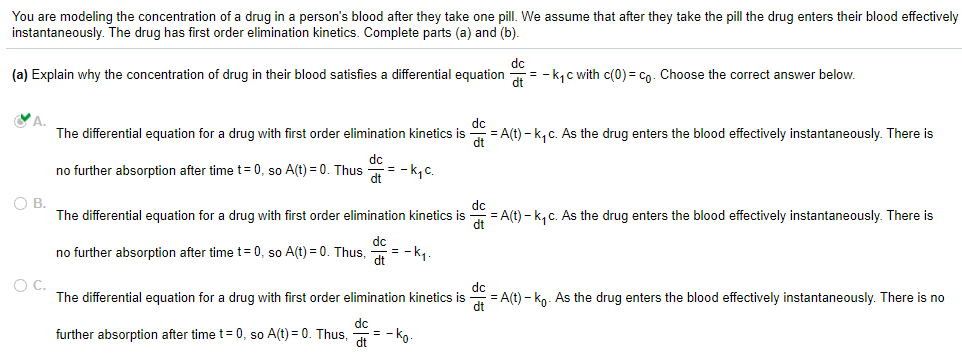(b) You measure the data given on the right for the concentration of the drug in a patient's blood. Write down the solution to the differential equation from part (a) in terms of co and k1- t (hrs) c(t) (mg/liter) 50 1 43.4 c(t) = C, e *;t Calculate the parameters co and k, that fit the model to this data. Co =D and k, = (Type integers or decimal rounded to three decimal places as needed.)
(b) You measure the data given on the right for the concentration of the drug in a patient's blood. Write down the solution to the differential equation from part (a) in terms of co and k1- t (hrs) c(t) (mg/liter) 50 1 43.4 c(t) = C, e *;t Calculate the parameters co and k, that fit the model to this data. Co =D and k, = (Type integers or decimal rounded to three decimal places as needed.)
Advanced Engineering Mathematics
10th Edition
ISBN:9780470458365
Author:Erwin Kreyszig
Publisher:Erwin Kreyszig
Chapter2: Second-order Linear Odes
Section: Chapter Questions
Problem 1RQ
Related questions
Topic Video
Question
2- please help with highlighted portion

Transcribed Image Text:You are modeling the concentration of a drug in a person's blood after they take one pill. We assume that after they take the pill the drug enters their blood effectively
instantaneously. The drug has first order elimination kinetics. Complete parts (a) and (b).
B. The constant k, represents the rate of elimination and constant co represents the initial concentration of drug in the blood.
O C. The constant k, represents the rate of elimination and constant co represents the final concentration of drug in the blood.
O D. The constant k, represents the rate at which drug is entering the blood and constant co represents the initial concentration of drug in the blood.
(b) You measure the data given on the right for the
concentration of the drug in a patient's blood. Write down
the solution to the differential equation from part (a) in
terms of co and k1.
t (hrs)
c(t) (mg/liter)
50
1
43.4
c(t) = Co
Calculate the parameters co and k, that fit the model to this data.
Co = and k, =
(Type integers or decimal rounded to three decimal places as needed.)

Transcribed Image Text:You are modeling the concentration of a drug in a person's blood after they take one pill. We assume that after they take the pill the drug enters their blood effectively
instantaneously. The drug has first order elimination kinetics. Complete parts (a) and (b).
(a) Explain why the concentration of drug in their blood satisfies a differential equation
= - k, c with c(0) = Cn. Choose the correct answer below.
dc
= A(t) - k, c. As the drug enters the blood effectively instantaneously. There is
The differential equation for a drug with first order elimination kinetics is
dt
no further absorption after time t= 0, so A(t) = 0. Thus
dc
= - k, c.
OB.
dc
= A(t) – k, c. As the drug enters the blood effectively instantaneously. There is
dt
The differential equation for a drug with first order elimination kinetics is
dc
no further absorption after time t= 0, so A(t) = 0. Thus,
= -k,
dt
OC.
dc
The differential equation for a drug with first order elimination kinetics is
= A(t) – kn. As the drug enters the blood effectively instantaneously. There is no
dt
dc
= - ko.
dt
further absorption after time t= 0, so A(t) = 0. Thus,
Expert Solution
This question has been solved!
Explore an expertly crafted, step-by-step solution for a thorough understanding of key concepts.
This is a popular solution!
Trending now
This is a popular solution!
Step by step
Solved in 2 steps

Knowledge Booster
Learn more about
Need a deep-dive on the concept behind this application? Look no further. Learn more about this topic, advanced-math and related others by exploring similar questions and additional content below.Recommended textbooks for you

Advanced Engineering Mathematics
Advanced Math
ISBN:
9780470458365
Author:
Erwin Kreyszig
Publisher:
Wiley, John & Sons, Incorporated

Numerical Methods for Engineers
Advanced Math
ISBN:
9780073397924
Author:
Steven C. Chapra Dr., Raymond P. Canale
Publisher:
McGraw-Hill Education

Introductory Mathematics for Engineering Applicat…
Advanced Math
ISBN:
9781118141809
Author:
Nathan Klingbeil
Publisher:
WILEY

Advanced Engineering Mathematics
Advanced Math
ISBN:
9780470458365
Author:
Erwin Kreyszig
Publisher:
Wiley, John & Sons, Incorporated

Numerical Methods for Engineers
Advanced Math
ISBN:
9780073397924
Author:
Steven C. Chapra Dr., Raymond P. Canale
Publisher:
McGraw-Hill Education

Introductory Mathematics for Engineering Applicat…
Advanced Math
ISBN:
9781118141809
Author:
Nathan Klingbeil
Publisher:
WILEY

Mathematics For Machine Technology
Advanced Math
ISBN:
9781337798310
Author:
Peterson, John.
Publisher:
Cengage Learning,

